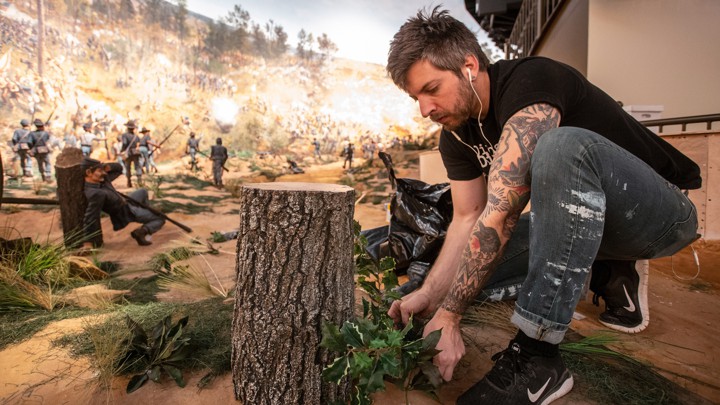Every city in the South, it seems, is trying to figure out what to do with its monuments. Richmond has kept its grand “Monument Avenue” lined with statues of Confederate luminaries. New Orleans took Robert E. Lee and Jefferson Davis down from their pedestals. In the city of Atlanta, whose leading Civil War monument is the enormous Atlanta Cyclorama, the strategy is novel: Use history itself to strip a divisive object of its symbolic power.
 Cycloramas are panorama paintings designed for exhibition in rotundas.
The viewer stands in the middle, cocooned by a canvas that becomes the
world. The Atlanta Cyclorama shows the 1864 Battle of Atlanta, a crucial
turning point in the Civil War that launched General William Tecumseh
Sherman on his infamous march and sealed the South’s fate. Now the
center of a major new exhibition at the Atlanta History Center, the
Cyclorama measures 49 feet high by 382 feet long and weighs more than
9,000 pounds, making it one of the largest paintings in the United
States.
Cycloramas are panorama paintings designed for exhibition in rotundas.
The viewer stands in the middle, cocooned by a canvas that becomes the
world. The Atlanta Cyclorama shows the 1864 Battle of Atlanta, a crucial
turning point in the Civil War that launched General William Tecumseh
Sherman on his infamous march and sealed the South’s fate. Now the
center of a major new exhibition at the Atlanta History Center, the
Cyclorama measures 49 feet high by 382 feet long and weighs more than
9,000 pounds, making it one of the largest paintings in the United
States.Ever since it premiered in 1886, the Cyclorama has itself been a battleground—a key theater in America’s 150-year fight over how to remember its Civil War. Some exhibitions have cast it as a Union victory; others as a Confederate one. At various moments, Union and Confederate veterans, white and black politicians, civil-rights leaders and segregationists have all tried to claim and control the Cyclorama. Some literally repainted it to promote their memory of the war. For much of the 20th century, the Lost Cause won out, and the Cyclorama served as Atlanta’s Confederate monument. It became part of an effort to uphold white supremacy under the guise of merely commemorating history.
The Cyclorama underscores why we care so much about monuments: not for the past they portray, but for the values they project into the present. “Southern white communities used monuments to preserve their version of the Civil War,” Sheffield Hale, the Atlanta History Center’s director, told me. “A statue of a Confederate general … is not about loss or grief. It is about power.”
When I spoke with Hale and his team of curators at the opening weekend late last month, they were very clear about the goal of the exhibition. They hope to end the Cyclorama’s career as a vessel for Civil War myths—to take away its power without erasing its history.
They have succeeded. The new exhibition transforms the Cyclorama from, as Hale puts it, “attraction to artifact”—from monument to museum piece. It shifts the focus almost entirely from the history depicted in the painting to the history of the painting itself; from the battle that the Cyclorama depicts to the battle over that battle. And in doing so, it shows how we might resolve the long debate over Civil War monuments. Instead of letting the monuments tell our history, we can tell theirs.
Over its 133-year existence, the Cyclorama has proved uniquely pliable as a Civil War memento, perhaps because it was designed that way.
In their 19th-century heyday,
cycloramas traveled from city to city, just as fairs or circuses did.
They needed to appeal to a wide audience. When the Milwaukee-based
American Panorama Company created the Atlanta Cyclorama, it instructed
its team (all German immigrants who spoke no English) to paint an
ambiguous juncture in the Battle of Atlanta: 4:45 p.m. on July 22, a
moment when four Confederate brigades had just broken the Union line and
taken control of Union artillery. Minutes later, Union reinforcements
led by General John Logan would beat back the Confederates and end the
threat. The Cyclorama depicts Logan on horseback, gallantly charging
toward the battle. But he wasn’t there yet. The scene is tense, the
outcome unresolved. The painters in Wisconsin crafted the Cyclorama to
depict an impending Union victory. From another angle, though, the scene
could also be interpreted as a Confederate opportunity. This was a
moment when the war could have gone the other way.
The report continues at The Atlantic


No comments:
Post a Comment